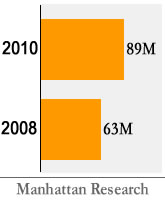The World Health Imaging, Telemedicine & Informatics Alliance has announced a new project — called the Healthy Communities Initiative — to help rural and urban community health centers obtain various health IT devices such as digital X-ray machines and telemedicine systems, Healthcare IT News reports.
WHITIA is a global not-for-profit organization that works to bring health care technologies to medical facilities in areas of limited resources.
According to WHITIA CEO Ivy Walker, community health facilities must be properly equipped with various health IT tools to provide comprehensive primary care services. Walker added that gaps exist in the community health center infrastructure because of a lack of adequate technologies.
WHITIA will begin the project by installing a digital X-ray system at Alivio Medical Center in Chicago (Monegain, Healthcare IT News, 1/14).
Source: iHealthBeat
 In 2010, 89 million U.S. adults tapped social media resources for health-related purposes, compared with 63 million in 2008 and 38 million in 2007, according to a Manhattan Research study.
In 2010, 89 million U.S. adults tapped social media resources for health-related purposes, compared with 63 million in 2008 and 38 million in 2007, according to a Manhattan Research study.
Consumers who used social media for medical purposes created or consumed content on blogs, chat rooms, message boards, online communities and patient testimonials.
According to the study, certain medical condition groups that tend to skew older, such as patients with cancer, are more likely to use social media for health reasons than their average age would predict.
Results are based on a Q3 2010 survey of 8,606 U.S. adults ages 18 and older.
Source: Manhattan Research, “Cybercitizen Health U.S.”
For any questions on social media and how it would fit into your practice, don’t hesitate to contact us.
A majority of U.S. residents think the federal government should invest more in medical innovation to improve the nation’s quality of life and provide for employment and economic growth, according to a survey from the Council for American Medical Innovation, Modern Healthcare reports (Zigmond, Modern Healthcare, 1/12).
Medical innovation usually is aligned with the use of IT, according to Healthcare IT News (Monegain, Healthcare IT News, 1/13).
The telephone survey polled 1,009 U.S. residents ages 18 and older from Jan. 6 through Jan. 10 (Modern Healthcare, 1/12).
Key Findings
According to the results, 58% of respondents said the government should spend more on innovation, while 72% said failure to do so would hinder future development and economic growth (Smith, “Tech Daily Dose,” National Journal, 1/12).
In addition, the survey found that:
Former House Majority Leader Dick Gephardt (D-Mo.) — co-chair of CAMI — said, “My perception is that we are falling way behind in medical innovation,” adding that advancements will help create jobs and incite economic growth (Modern Healthcare, 1/12).
Source: iHealthBeat
 On Monday and Tuesday, more than a dozen physicians and representatives of hospitals discussed challenges associated with meeting requirements under the meaningful use program, AHA News reports.
On Monday and Tuesday, more than a dozen physicians and representatives of hospitals discussed challenges associated with meeting requirements under the meaningful use program, AHA News reports.
Under the 2009 federal economic stimulus package, health care providers who demonstrate meaningful use of electronic health records can qualify for incentive payments through Medicare and Medicaid (AHA News, 1/11).
Attendees spoke during a two-day meeting of the Implementation work group of the Health IT Standards Committee. The speakers were advanced users of EHRs, according to Modern Healthcare (Conn, Modern Healthcare, 1/12).
Attendees’ Concerns
Attendees said that many hospitals will face challenges complying with the incentive program’s meaningful use requirements.
Joanne Sunquist — CIO of Minneapolis-based Hennepin County Medical Center — said developing reports to demonstrate meaningful use “has become an onerous, difficult and time-consuming process” (Page, Becker’s Hospital Review, 1/12). Sunquist added that health care organizations might encounter difficulty implementing quality reporting systems using vendor-provided workflow information (Goedert, Health Data Management, 1/12).
According to Charles Christian — CIO of Good Samaritan Hospital in Indiana — smaller facilities could experience difficulty implementing health IT because they might not have appropriate in-house staff and would have to rely on outside help.
Linda Reed — vice president and CIO of Atlantic Health in New Jersey — said that physicians need more guidance on implementing technology to support health information exchange (Monegain, Healthcare IT News, 1/12).
According to Lyle Berkowitz — medical director of clinical information systems at Chicago-based Northwestern Memorial Physicians Group — independent physician practices are at a disadvantage because they do not have access to resources compared with hospital-affiliated groups (Modern Healthcare, 1/12).
Meeting attendees called for HHS to provide more time before implementing the incentive program’s Stage 2 requirements (AHA News, 1/11).
Source: iHealthBeat
Scientists are developing new technology capable of tracking medication once it has been ingested, the Los Angeles Times reports.
By using new technology, next-generation pills aim to help patients adhere to their medication regimen and address issues with patient adherence to physician instructions.
The new technology is aimed at benefiting patients with chronic or complex ailments where forgetting to take medication properly can carry adverse health effects.
Another area that requires proper compliance when taking medication is in clinical trials. Currently, participants in clinical trials keep diaries to chart their medication regimen, but drug companies spend extra money to ensure the trials have a sufficient number of participants to account for those who fail to properly take their medication, according to the Times.
Examples of New Pills
Maysam Ghovanloo, an electrical engineer at the Georgia Institute of Technology, is developing MagneTrace, a necklace that uses radio-frequency identification to record every time a pill moves through the esophagus. The RFID chip on the pill is coated with non-reactive material so it will dissolve and allow the hardware to pass through the digestive system.
The necklace also can send an alert to a cell phone notifying the patient when the next dose should be taken.
A similar technology is the ID-Cap, developed by University of Florida electronic engineer Rizwan Bashirullah.
The ID-Cap is a sticker that is half the size of a postage stamp and that contains a microchip, antenna and acid sensor. The cap sends electronic signals through body tissue to a receiver, worn on the wrist. Bashirullah estimates that if demand for the new devices is high, they could cost less than one dollar per pill.
Privacy Concerns
Bashirullah said that information such devices produce is under patients’ control.
He added that the pills do not differ substantially from electronic implants such as pacemakers and other devices that transmit heart rate data (Dance, Los Angeles Times, 1/10).
Source: iHealthBeat
 Many caregivers who use health IT tools to help care for family members or friends believe emerging technologies such as mobile health devices and personal health records will significantly benefit them and their care recipients, according to a recent study by the National Alliance for Caregiving and UnitedHealthcare, InformationWeek reports.
Many caregivers who use health IT tools to help care for family members or friends believe emerging technologies such as mobile health devices and personal health records will significantly benefit them and their care recipients, according to a recent study by the National Alliance for Caregiving and UnitedHealthcare, InformationWeek reports.
The study was based on a November online survey of 1,000 caregivers who provide at least five hours per week of unpaid care to an adult relative or friend. All of the caregivers in the survey use the Internet or some other technology to help provide care.
Expected Benefits
In response to questions about the expected benefits of using health IT tools, the researchers found that:
Top Three Tools
The survey also identified three health IT tools that appeared to have the greatest potential to improve care because they appealed to a large number of caregivers and had minimal barriers to adoption. The top three tools identified were:
Perceived Barriers
Although many caregivers saw promise in health-related technologies that were not in the top three tools, more than half said certain barriers would prevent them from using the tools.
The most commonly reported obstacle was price, with 37% of respondents saying that they believed the tools would be expensive.
Some respondents also reported a concern that the care recipient might not be receptive to trying new technologies.
Addressing the Concerns
The study identified three strategies that could encourage caregivers to try new health care technologies. The survey found that:
Source: iHealthBeat
 There are more than 200 million mobile health care applications currently in use, according to a recent Pyramid Research report, InformationWeek reports.
There are more than 200 million mobile health care applications currently in use, according to a recent Pyramid Research report, InformationWeek reports.
According to the report — titled “Health Check: Key Players in Mobile Healthcare” — the number of mobile health apps will increase threefold by next year.
The report stated that the growing popularity of mobile health apps will increase innovation in health care delivery but highlighted potential barriers to adoption among health care providers, including:
The report also found that about 70% of people worldwide are interested in at least one mobile health app and that the value proposition of mobile health is strong.
In addition, the report included information about how the growth of mobile health gives technology companies access to a large customer base (Lewis, InformationWeek, 1/5).
Separate Study Evaluates Mobile Health Market
A new report from health care market research company Kalorama Information estimates that the medical mobile health market was worth $84.1 million in 2010, up from about $41 million in 2009.
According to the report — titled “The Worldwide Market for Mobile Medical Apps” — more than 50% of physicians used PDAs or smart phones on a daily basis in their work.
The average price for most medical apps was $15, the study found (Merrill, Healthcare IT News, 1/6).
The report found that health care apps made up approximately 1.5% of the total mobile apps market in 2009 (Byers, CMIO, 1/4).
Source: iHealthBeat
 The Office of the National Coordinator for Health IT plans to collect information about health IT trends to help HHS agencies stay up to date on potential breakthroughs in health care delivery, according to a recent announcement on the Federal Business Opportunities website, Government Health IT reports.
The Office of the National Coordinator for Health IT plans to collect information about health IT trends to help HHS agencies stay up to date on potential breakthroughs in health care delivery, according to a recent announcement on the Federal Business Opportunities website, Government Health IT reports.
ONC plans to partner with health IT experts, innovators and developers to identify emerging trends in health care technology.
The office will update CMS and the Agency for Healthcare Research and Quality about the most promising health IT developments that could support broader health IT adoption and the achievement of meaningful use.
Under the 2009 federal economic stimulus package, health care providers who demonstrate meaningful use of electronic health records will qualify for incentive payments through Medicare and Medicaid.
According to the announcement, the trend-scanning initiative could help policymakers identify innovative technological advances that could shape the future of policy decisions on health IT (Mosquera, Government Health IT, 1/5).
Source: iHealthBeat
 Patients increasingly are making appointments to meet with physicians online via web cameras, MyHealthNewsDaily/Yahoo! News reports.
Patients increasingly are making appointments to meet with physicians online via web cameras, MyHealthNewsDaily/Yahoo! News reports.
Online chat services such as Skype allow doctors to meet with patients in a quick and convenient capacity, according to MyHealthNewsDaily/Yahoo! News. The services also allow for specialty physicians, such as plastic surgeons, to interact with patients in distant cities.
In addition, the technology helps patients with illnesses confine their germs to the home.
Trend Growing
According to Gary Capistrant — senior director of public policy at the American Telemedicine Association — there are limited data on how many doctors use webcams at their practices because no agency tracks or requires doctors to report when they use webcams.
However, he said the number is “absolutely increasing” as patients gain more ways to access video chat programs, such as through smart phones.
Potential Problems
Physicians using webcams to consult with patients soon could see significant obstacles, as state laws likely will grow more restrictive as technology advances, according to Capistrant.
Physicians must be licensed in the state where their practice is located and in any state where they see patients through videoconferencing. However, Capistrant said that some states have agreements with others to accommodate doctors who see patients across state lines.
In addition, Capistrant said doctors must make sure their communication with patients meets HIPAA security requirements.
Physicians also might be forced to reconsider how they bill patients as the practice of using webcams becomes more common. Most doctors charge patients the same price for in-person visits as they do for a web-based appointment. However, technology could shorten the length of many appointments — perhaps even reducing certain exchanges to a text message, according to Capistrant.
Finding a Balance
Doctors say that in-person visits still are preferable because they often can pick up on nuances not obvious through video.
Certain physicians will agree to use webcams only if they already have seen the patient several times in person (Chan, MyHealthNewsDaily/Yahoo! News, 1/2).
Source: iHealthBeat
Websites that allow patients to book physician appointments online are becoming increasingly popular as doctors work to reduce their overhead costs and patients strive to book appointments sooner, Kaiser Health News/USA Today reports.
According to the American Academy of Family Physicians, about 16% of family physicians used online scheduling tools in 2009, up from 6% in 2005. Some of the other factors fueling the growth of online scheduling applications could include:
Online Scheduling Tools
The online physician scheduling website ZocDoc began in 2007 in New York City and has expanded to Chicago, Dallas and the Washington, D.C., area. About 40% of the appointments made on the website take place within one day of booking and almost 85% of appointments are new patients.
Although patients do not have to pay to book an appointment, doctors pay about $250 monthly to be listed on the site. The website offers information on physicians’:
Health in Reach, another online scheduling tool, started in September 2010 as a service for patients in Los Angeles. The company receives income by charging doctors a fee for confirmed appointments (Galewitz, Kaiser Health News/USA Today, 1/4).
Source: iHealthBeat
 MGMA Supports ICD-10 Testing With Outside Organizations
July 30, 2013
MGMA Supports ICD-10 Testing With Outside Organizations
July 30, 2013
 Report: Many EHR Users Set To Replace Systems Within the Next Year
July 30, 2013
Report: Many EHR Users Set To Replace Systems Within the Next Year
July 30, 2013
 Providers, Vendors Urge Congress To Delay Meaningful Use Stage 2
July 30, 2013
Providers, Vendors Urge Congress To Delay Meaningful Use Stage 2
July 30, 2013
 Many Doctors May Find Meeting ‘Meaningful Use’ Requirements a Challenge
June 28, 2013
Many Doctors May Find Meeting ‘Meaningful Use’ Requirements a Challenge
June 28, 2013
 When it Comes to ICD-10 Physician Documentation: Collaborate and Educate
June 28, 2013
When it Comes to ICD-10 Physician Documentation: Collaborate and Educate
June 28, 2013
 The Slow Crawl Toward Improved EHR Usability and Interoperability
June 28, 2013
The Slow Crawl Toward Improved EHR Usability and Interoperability
June 28, 2013
 Efficient Patient Communication and Engagement
June 13, 2013
Efficient Patient Communication and Engagement
June 13, 2013
 ONC Issues Guidance on Stage 2 Transition of Care Requirements
May 31, 2013
ONC Issues Guidance on Stage 2 Transition of Care Requirements
May 31, 2013
 Drugmakers Leverage Doctor, Patient Data To Market Their Products
May 31, 2013
Drugmakers Leverage Doctor, Patient Data To Market Their Products
May 31, 2013
 Consumer Organizations Defend Meaningful Use Program
May 31, 2013
Consumer Organizations Defend Meaningful Use Program
May 31, 2013
Copyright 2015 - Pulse Practice Solutions | 615.425.2719
